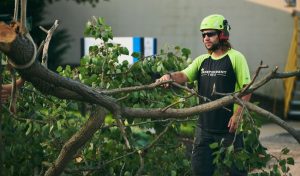Written by Deborah Stephenson and published on https://homeguides.sfgate.com/.
Factors such as frost and decay can cause you to have a newly fallen tree to clean up. You may be wondering, therefore, where to dispose of fallen trees. There are a variety of options to choose from, and you really just need to pick the one that works best in your area. First, however, here are some things to consider.
The Best Way to Get Rid of a Fallen Tree
Trees can fall suddenly for many reasons. Thunderstorms, tornadoes and hurricanes, even earthquake activity or wildfire, may contribute to toppling them. Sometimes they merely get old and fall apart naturally. Establishing the reason a tree falls is important, because most municipalities offer some removal aid in cases of natural or widespread disaster, while a rotten tree on your own property will likely be your problem alone. Start by determining where the responsibility for the tree lies before deciding what to do about the tree.
Determine Responsibility
 If you live in the city or suburbs, you see trees along streets or in parks and public areas. Those trees are almost always maintained by the city or in some instances by county or state agencies. If a tree from one of those areas falls on your property, call your local officials to identify the responsible agency, then arrange with them for getting rid of it. If you are uncertain whether a tree is on your property, a public property or your neighbor’s property, consult your title survey or plat map. If the tree is definitely yours, you must remove it yourself or consider paying someone to do the job for you.
If you live in the city or suburbs, you see trees along streets or in parks and public areas. Those trees are almost always maintained by the city or in some instances by county or state agencies. If a tree from one of those areas falls on your property, call your local officials to identify the responsible agency, then arrange with them for getting rid of it. If you are uncertain whether a tree is on your property, a public property or your neighbor’s property, consult your title survey or plat map. If the tree is definitely yours, you must remove it yourself or consider paying someone to do the job for you.
Firewood
Having a tree on the ground in your yard may seem like a disaster, but looked at in a positive light, it can be a boon. If you heat your home with wood or own a fireplace, you know that buying firewood is expensive. Think of your fallen tree as almost-free firewood — you still have to pay for a chain saw and fuel to power it. If you don’t need firewood, you can still save some of it for the backyard fire pit and sell the rest to someone who does use it. Better yet, save the hassle and expense of cutting it up yourself by offering it free for someone else to cut and haul. Do consider potential accidents, however. If your insurance policy doesn’t cover such things, make sure the person who does the cutting is clearly covered by his or her own policy or bond.
Landscaping
Depending upon your landscaping design, a large fallen tree — especially its trunk and bigger limbs — could be an asset. A section of the trunk situated in a woodland setting makes a wonderful natural bench, or you can cut short logs about 2 feet long to use as rustic stools. Another somewhat taller section makes a sturdy base for a garden table — all you need is a salvaged tabletop. Put branches in a brush pile to attract wildlife to the garden, or use appealingly shaped branches as accents for a rustic fence or an informal wildflower bed. Nature loves an old rotting log, so even if you don’t want it for your own use, consider letting it decay in an out-of-the-way corner as a home for insects, voles or chipmunks.
Lumber
Some trees are more valuable than others. If your tree is old, rotten or of poor quality, use it for firewood or brush piles. But if you are lucky enough to have a mature walnut, cherry, redwood or other furniture-wood tree in reasonably good shape, think about hauling workable sections to a mill for cutting it into lumber. Alternatively, rent a portable lumber mill, or hire someone to operate one for you, and mill the wood onsite. Season your lumber, and set it aside for future wood-working projects. To learn which wood has lumber value, contact your state forestry or conservation department or contact the U.S. Forestry Service and ask them to direct you to local forestry information sources.
Safety
Never operate a chain saw or other power equipment, such as a chipper-shredder, without a thorough knowledge of the operation of these dangerous tools. Always wear safety gear such as steel-toed boots, chainsaw chaps and gloves, and safety goggles, helmet and hearing protection. If you do not understand how to properly use a chain saw, don’t. Hire a professional.
Original post here https://homeguides.sfgate.com/way-rid-fallen-tree-76790.html.


